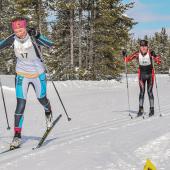Balance Training and Physical Performance
Few people would argue the importance of muscular strength and cardiovascular conditioning to overall health and well-being. But what about balance training? How important is balance to the performance of everyday activities or to physical performance during exercise? Balance is the ability to effectively translate the power of your muscular and cardiovascular systems into efficient movement such that the movement appears effortless.
Imagine riding down a steep single-track trail in the Gallatin Range on your mountain bike. Dodging trees and rocks, the pedals are cranking and the mud is flying. Good balance keeps you riding fast and in control. Yes, the difference between good balance and great balance is the ability to turn everyday recreational activities into your own personal X-Games. Not only is this fun, but it can help prevent injuries by minimizing falls or falling with minimal impact.
What is Balance?
Balance is the ability to maintain a static or dynamic equilibrium though the integration of neuromuscular, vestibular, and visual feedback to the central nervous system. The central nervous system uses this information to determine the relative location of your limbs and torso, as well as the absolute location of your body in three-dimensional space. Most research on balance has been performed on populations where balance is either developing (children) or deteriorating (the elderly).
In older adults, balance is usually discussed in terms of postural stability and the ability to maintain a stable position or motion in the presence of destabilizing factors such as loose or crumpled carpets and objects on the floor. Older adults, in fact, experience over 250,000 fall-related hip fractures each year that result in long-term disability and death. Clearly, this is reason enough for researchers and clinicians to focus their efforts on balance intervention and training in the elderly.
What we have learned from studying the elderly is that balance is a skill-based fitness component that tends to erode with age (due to physical inactivity) but is trainable regardless of age. Balance is a skill that adults lose with advancing years because they stop challenging themselves.
Importance of Balance
Without balance, strength and cardiovascular conditioning cannot be effectively applied to physical activities. Thus, balance is truly the foundation of all human movement. Nowadays, fitness gyms are filled with balance training devices (stability trainers, wobble boards, etc.) that can be integrated into your training program. However, why go to a gym when everyday life is filled with opportunities to challenge your balance? The true key to balance training is to challenge your ability to remain in control by purposely performing an activity slightly out of control. Outlined below are recreational activities that can be used to train your sense of balance.
Everyday Recreational Activities
For most Americans, especially many older adults, walking and stair climbing are the best everyday activities for emphasizing balance training in combination with cardiovascular and muscular conditioning. Walking on uneven surfaces, such as trails or snow, will exaggerate the importance of balance and thus provide a better stimulus for balance training. Weight training is also great balance training when using free weights or your body weight for resistance. The very act of lifting a weight from the floor to perform dumbbell curls or standing military press forces your nervous system to deal with a changing center of mass (where the mass is that of your own body and the weight).
Activities for the Adventurous Spirit
Do you want to challenge your physical abilities, improve dynamic balance, as well as learn a useful dating skill? Try dancing (ballroom, Latin, swing, modern) to convert your feet of iron into grace and fitness that translate well to improved balance during recreational activities. Similarly, most forms of martial arts (aikido, judo, jujitsu, karate, taekwondo) rely on a highly developed sense of both static and dynamic balance, as well as helping you defeat the school bully and get the girl of your dreams (okay, so I may have watched The Karate Kid one too many times). Other forms of exercise, such as yoga or pilates, can also be extremely effective for improving balance. However, these exercises tend to emphasize static rather than dynamic balance exercises so your improved balance may translate less effectively to dynamic recreational activities.
Activities for the Athletically Inclined
For many of us, balance training is best experienced when telemarking fresh powder, snowshoe-running in the Gallatin Range, trail running through the Bridgers, or hiking alpine-style to the summit of Hyalite Peak. However, in my opinion, the best outdoor activity for training dynamic balance is mountain biking up and down steep terrain. My first time mountain biking up steep single-track left me bruised (from the falls) and my ego deflated. The ability to generate power while climbing slowly through loose dirt and over slick rock is an amazing challenge to static and dynamic balance. Similarly, anyone’s sense of balance can be challenged when riding fast down a steep single-track trail while navigating slick roots, sharp corners, and downed trees.
In summary, balance is a trainable characteristic that influences both everyday activities and exercise performance. The key to improving either static or dynamic balance is to perform activities that allow you to challenge your balance while remaining low risk and fun.
Dan Heil, an Associate Professor in Exercise Physiology at Montana State University-Bozeman, is constantly searching for better balance in life as well as during exercise.













